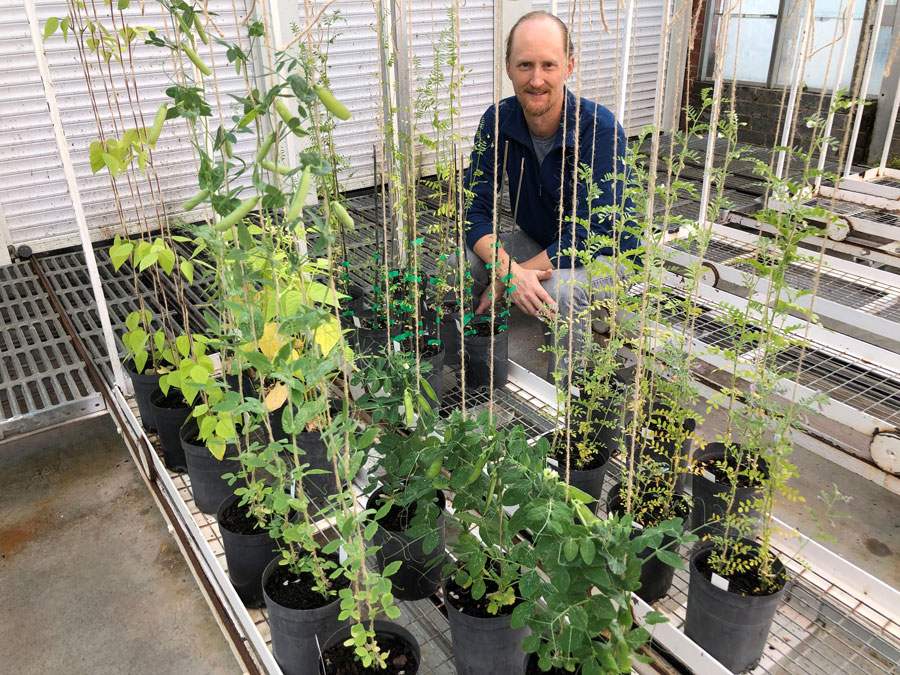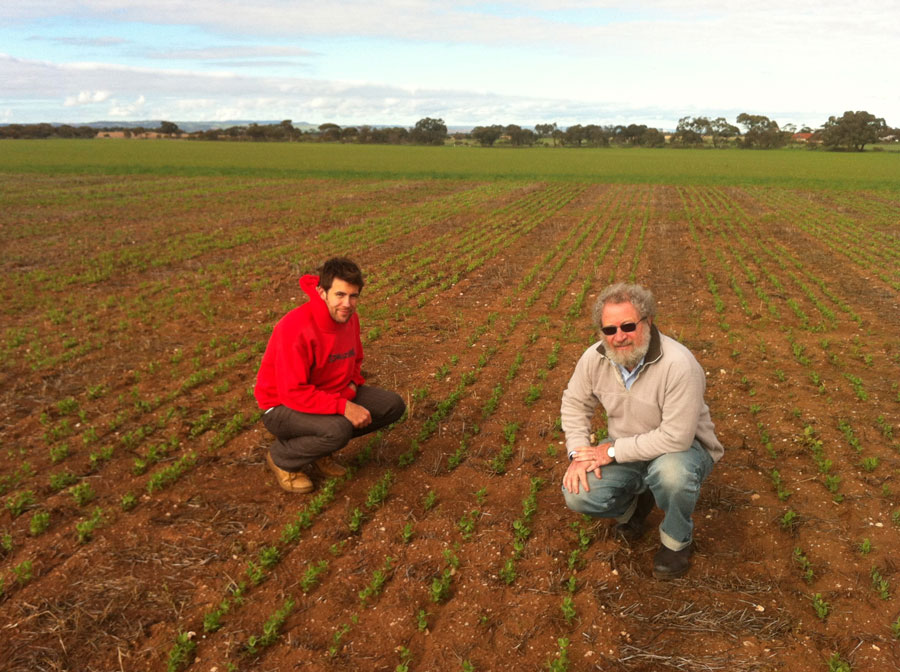Key points
- Unique features of pulses are being tapped to improve adaptation of the species across Australia
- Identifying phenology and targeting the optimal flowering period for chickpea and lentil in the first instance will contribute to minimising risk and improving yield
- Harnessing international expertise and data from extensive field trials will enhance Australian pulse breeding programs
- Genetic understanding of pulse adaptation will help match changing climates
Relative to other crops such as cereals and canola, pulse phenology is uniquely flexible, which presents significant opportunities to improve adaptation of these species to a range of environments.
Phenology is a general term that refers to the timing of events in the plant growth cycle and is one of the traits at the heart of crop adaptation.
Many crops show considerable variation in phenology, reflecting differences in their ability to respond to photoperiod (daylength), vernalisation (cold) and temperature. Often threshold levels of photoperiod, vernalisation or heat are needed to trigger key transitions.
As a result, varieties that perform well in one location may be next to useless in others where threshold requirements are not met, even though they may possess other potentially valuable production and market traits.

University of Tasmania's Associate Professor Jim Weller in the university's phytotron which allows plants to be grown in controlled daylengths. Photo: University of Tasmania
Adaptive variation
The most recognisable phenology 'event' is flowering time, but the onset and duration of other stages in plant development are often also important; phenology is also associated with other traits such as vigour and growth habit.
Variation in phenology reflects underlying genetic differences that have allowed crop cycles to be tailored to location-specific seasonal patterns of daylength, rainfall and temperature. It provides a way of managing exposure to damaging heat and cold, water deficit, frost and disease through cultivar selection and sowing date.
However, this same variation in many cases prevents a simple and effective transfer of varieties from one growing region to another and complicates the process of transferring valuable traits from exotic to local varieties through breeding.
Even for high-yielding varieties, performance may be restricted to a particular region, can vary widely from year to year, or respond in unexpected ways to shifts in sowing date. This is due, in part, to how well-matched the phenology is to local conditions.
Ultimately, a key goal of this program is to develop and provide growers with a better range of high-yielding options for different locations and management approaches, and help to expand pulse production and improve profitability of pulses across Australia.

SARDI's Dr Lachlan Lake (left) and Associate Professor Victor Sadras will oversee the field evaluation. Photo: SARDI
On top of that is the fact that we now need to seriously consider changes to environmental conditions that are likely to develop in future and factor these into the development of new varieties.
One feature of pulses that is different from cereals is that flower opening, fruit (pod) development and grain (seed) filling happen sequentially and over an extended period. This can be an advantage or a disadvantage in different situations and cannot be understood by direct comparison with other major crop groups, so it requires a specific focus on pulses.
A good understanding of phenology and how it is controlled by genetics and environment can help breeders and agronomists respond to grower needs and market demands. This will assist growers to select varieties with appropriate flowering and maturity for their specific production environment.
This understanding is also an important component in the development of models that will help us predict and respond to changing climate and expand growing areas.
International collaboration
Over the past decade, researchers at the University of Tasmania have been working with colleagues in Canada, the US, Spain, France and China to gain a better understanding of phenology across several important pulse crops, including field pea, chickpea, lentil, common beans and soybean.
These connections are linking Australian experience in fundamental pulse physiology and genetics research with the expertise of leading pulse breeders and researchers in national research programs at institutions such as the Crop Development Centre at the University of Saskatchewan, the US Department of Agriculture, the Chinese Academy of Sciences and the French National Institute for Agricultural Research (INRA).
The networks provide priority access to valuable new genomic resources being generated by these groups, as well as access to a wealth of information from coordinated field trials across the world's major pulse-growing regions.
This information is allowing detailed knowledge to be developed of environmental and genetic factors that control differences in pulse phenology at global, regional and local scales, and to apply this knowledge to improved adaptation in Australia.
Genetic understanding
Over the past 10 years, the University of Tasmania and collaborators have identified genes that contribute to major differences in phenology in these crops.
These include identification of major genes controlling the winter/spring flowering difference in field pea and the major variant in Precoz lentil that confers early flowering, which has driven improvements in lentil productivity in many short-season production environments globally. More recently, key genes for early flowering and photoperiod insensitivity have also been defined in common beans and chickpea, as well as additional genes in pea and lentil (see Figure 1).
Figure 1: Genetic variation in lentil shows how specific genes contribute to daylength sensitivity for flowering time, growth habit and maturity. Under conditions where the reference line (A) flowers late, lines with gene variants introduced from South Asian accessions flower early (B and C). Where plants have flowered, the first open flower is indicated by an orange arrow.

Source: UTas
New GRDC investment will help accelerate this work and support a specific focus on chickpea and lentil in Australian production environments. This project is based at the University of Tasmania and will include important contributions from other Australian partners such as the South Australian Research and Development Institute, CSIRO and the University of Western Australia, and links to major pulse-improvement programs in Canada, the US and Europe.
The project will enable the team to find additional variation relevant for Australian breeders, define its distribution within Australian breeding material and improve understanding of how it will affect performance in any given location. This will be done through multi-site field evaluations and the use of specialised controlled-environment facilities at the University of Tasmania, in parallel with detailed genetic (laboratory) and genome (computational) analyses for gene discovery.
Application
The project aims to generate several specific outputs.
First, knowledge about specific genes and their influences in field and controlled conditions will allow current varieties and new varieties under development to be accurately classified. Development of specific genetic markers for phenology will allow early and efficient selection for different adaptation types during breeding. Close attention to the unique features of pulse phenology will also clarify whether different stages of growth can be independently adjusted by breeders to suit specific situations.
Second, the project will provide practical tools in the form of specifically developed 'sets' of varieties that differ in major phenology genes. These will be used by agronomists for more detailed evaluations and modelling of how phenology interacts with other environmental and management factors to influence yield. They include aspects such as sowing date and rate, soil moisture, soil type, disease and chilling, frost and heat stress.
Overall, this knowledge will help breeders make informed choices of material in developing new varieties for established pulse production regions in Australia and regions of potential expansion. It will also make it easier and quicker for breeders to introduce disease and stress-tolerance traits from wild relatives and other exotic material; this is an approach supported by GRDC and increasingly used in plant-breeding efforts worldwide.
Ultimately, a key goal of this program is to develop and provide growers with a better range of high-yielding options for different locations and management approaches, and help expand pulse production and improve profitability of pulses across Australia.
GRDC's investment in a national pulse phenology program, beginning with chickpea and lentil, is expected to be an effective and efficient way to focus existing research in Australia and minimise the duplication of effort across regions and research projects. It will also benefit from the approaches developed and the experience gained in other national phenology programs in crops such as wheat and canola and will be closely aligned with a new initiative in pulse agronomy.
Another advantage is that it will help promote existing and new links with several major pulse improvement programs internationally, which will provide mutually beneficial access to state-of-the-art resources, technologies and scientific insights. It will allow the Australian pulse industry to better coordinate with, leverage and learn from the experience of pulse researchers, breeders and growers around the world.
More information: Associate Professor Jim Weller, 03 6226 7828, jim.weller@utas.edu.au

























































